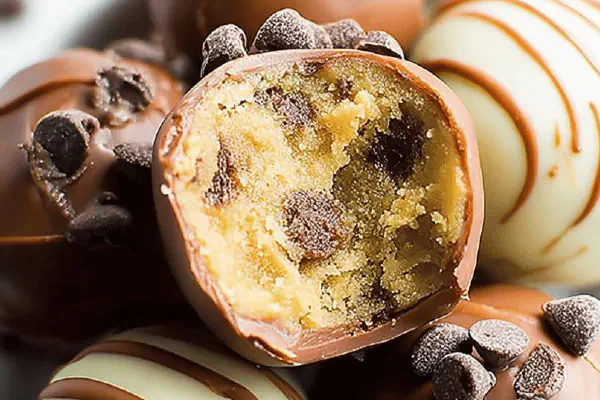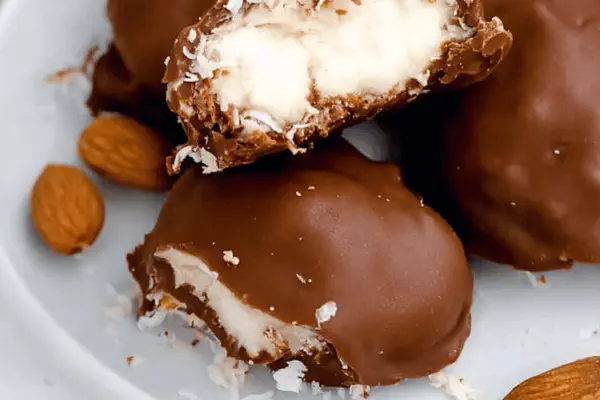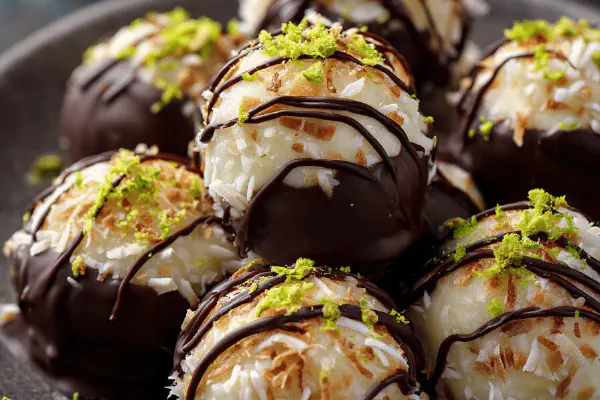Snowball Truffles

By Emma
Certified Culinary Professional
Ingredients
- 110 g shredded coconut (toasted, unsweetened)
- 350 g white chocolate, chopped
- 1/2 vanilla bean, split and scraped
- 140 ml heavy cream 35%
- 10 ml light corn syrup
- 25 ml unsalted butter, softened
- 3 ml almond extract
- Pinch sea salt
About the ingredients
Method
- Lightly toast coconut in dry pan until fragrant and just golden. Set aside to cool.
- Finely grind half the toasted coconut in coffee grinder or with sharp knife. Reserve the rest for coating.
- Place chopped white chocolate in a heatproof bowl.
- Bring cream to near boil with vanilla seeds & split pod, corn syrup, and sea salt. Remove vanilla pod before pouring hot cream over chocolate in three parts.
- After each pour, wait 1 minute, then gently whisk from center out, careful not to pick up air, until silky and shiny.
- Fold in butter and almond extract off heat. The ganache should be thick but spreadable.
- Cover ganache tightly with plastic, pressing directly on surface to avoid skin. Chill for about 2½ hours until quite firm but scoopable.
- Use small cookie scoop or tablespoon to portion out ganache quickly. Roll between palms, making evenly sized balls. Avoid warming too much or it melts.
- Roll truffles in the finely ground coconut first, then in the larger flakes. The dual texture adds interest.
- Arrange on parchment-lined tray. Chill at least 45 minutes for set before serving.
- For storage: keep airtight in fridge up to a week. Let sit at room temp 10 min before serving for best mouthfeel.
- If ganache overheats, it can seize; strain or remelt gently with little cream to fix. If too soft, extend chilling and handle quickly to shape.
- Optional: Experiment with toasted nut dust (macadamia or hazelnut) for unique coating variations.
Cooking tips
Chef's notes
- 💡 Toast coconut till just golden. Watch closely. Burnt bits ruin subtle crunch. Use dry pan, no oil. Smell changes from raw to toasty nutty scent. Cool fully before grinding. Grinding half fine, half coarse keeps texture contrast in truffle coating. Skip sweetened coconut for less sugar; adjust salt then.
- 💡 Heat cream with vanilla seeds gently. Listen for faint pop bubble sound. Avoid full boil or scalding cream. Pour hot cream slowly over chopped chocolate in three parts. Wait 1 minute each, whisk gently center out, no air bubbles. Slow melt keeps shine, stops grainy texture. Whisk direction matters to keep glossy ganache.
- 💡 Butter and almond extract added off heat. Fold gently. Over mixing beats air inside, tough ganache. Butter softens texture, almond extract adds depth beyond just vanilla bean. Vanilla bean better than extract for aroma, but double extract if none. Butter must be softened, not melted or cold lumps appear.
- 💡 Wrap ganache directly on surface with plastic to avoid skin. Skin ruins smooth texture and balls turn bumpy. Chill until just firm enough to scoop but still tender inside. Finger press test: slight give, no stick, no brittle crack. Timing varies by fridge coldness and cream fat percentage. Prepare scoop and roll fast to avoid melting.
- 💡 Rolling truffles fast but careful. Warm hands melt ganache. Use small scoop to portion evenly. Roll in finely ground coconut first to stick well, then coat in larger flakes for crunch. Too much coconut powder makes chew dry; balance is key. Chill again after rolling to firm coating hold. Alternative coatings: toasted nut dust like macadamia or hazelnut for texture variations.
Common questions
Why add corn syrup?
Stops sugar crystallization in ganache. Makes texture smoother. Can swap glucose syrup or omit but risk grainy finish. Just keep stirring slow, temperature low if skipped.
What if ganache overheats?
Seizes or grainy textures happen. Fix by straining or gently remelting with a splash of cream. Overheat kills gloss. Patience in heating crucial. Sometimes adds butter again to bring back silkiness.
How to store truffles properly?
Airtight container in fridge best. Up to a week max. Room temp 10 minutes before serving softens centers nicely. Freeze? Possible but texture changes. Wrap balls individually if freezing to protect.
What to do if ganache too soft or firm?
Too soft means extend chilling or add more butter next batch. Too firm can come from overchilling or insufficient butter. Temperature adjustments, fat content of cream affect texture a lot. Adjust and test.



